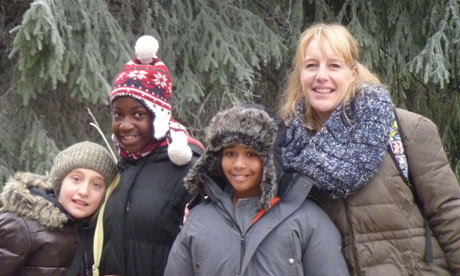
The soaring Norwegian spruce in London's Trafalgar Square – it's the most celebrated of all Christmas trees!
When the Poetry Society and the Royal Norwegian Embassy invited me to be part of Look North More Often, their Christmas tree project, my heart leaped because glittering Norwegian threads have always woven in and out of my own life. My mother was engaged to a pilot who flew risky missions to Norway during the second world war, and my Minnesotan wife is half-Norwegian. I've retold the racy, ice-bright myths of the Vikings and this year I published Bracelet of Bones, the first novel in a trilogy following a Viking girl on her journey from Norway to Constantinople.
Recently I joined three English primary school children, their teacher and several parties of Norwegian children in a silent forest outside Oslo – a magical place lit by silvery hoar-frost and the sheer voltage of everyone's excitement. There we stared into a crackling pine fire until our eyeballs burned, we devoured bowls of stew, the children drank juices and the adults gulped coffee served from sooty, fire-blackened kettles. Then the singing began. We joined hands and swore lasting friendship (and meant it), and we all witnessed the felling of the glorious tree destined for Trafalgar Square.
This tree is 48 years old (10-year old Elijah and I counted the rings) and all but 30 metres tall. As a blond, bearded giant severed the tree from its roots, she didn't crash sideways but was lifted heavenward by a vast crane. The massive branches bounced and slowly settled, and several people around me moaned before they cheered, conscious of death-in-life, life-in-death, while I found myself thinking of how Viking children once honoured the mighty ash tree, Yggdrasill, with its branches spreading out over the nine worlds of Norse mythology.
This spruce selected for Trafalgar Square is known as "the queen of the forest", and she's shipped across the North Sea to Immingham, then brought by lorry to London as an annual gift from the city of Oslo to the city of Westminster. Now she embodies the close friendship of the people of Norway and Britain, but the tree was first given in 1947 to celebrate and commemorate British support for Norway during the second world war. After Norway had been invaded by German forces in 1940, King Haakon VII escaped to Britain, and a Norwegian government-in-exile was set up in London. The BBC relayed news about the war in Norwegian, as well as maintaining an information network which became vital to the resistance movement.
Days shorten; the year darkens. Then scaffolding is erected in Trafalgar Square, the tree is winched up. Her trunk is pushed four feet into the soil beneath grey stone slabs, secured with a dozen wooden wedges. As part of the Look North More Often project, poems by English children have decorated the billboards around the base of the tree. And then, at 6pm on 1 December, the lights of the National Gallery are dimmed. A brass band plays, children read words in the tree's honour. And, at the flick of a switch, the tree comes alive again: a mass of twinkling lights, all of them white, in line with Norwegian tradition.
What is home? 'Snow and spruce forest is home', says the poet Tarjei Vesaas. 'Snø og granskog er heimsleg'. But the queen of the forest, meanwhile, has made her long journey to Trafalgar Square – and to her second home into the hearts of the hundreds and thousands who marvel at her.

